Lyons W.C. (ed.). Standard handbook of petroleum and natural gas engineering.2001- Volume 1
Подождите немного. Документ загружается.

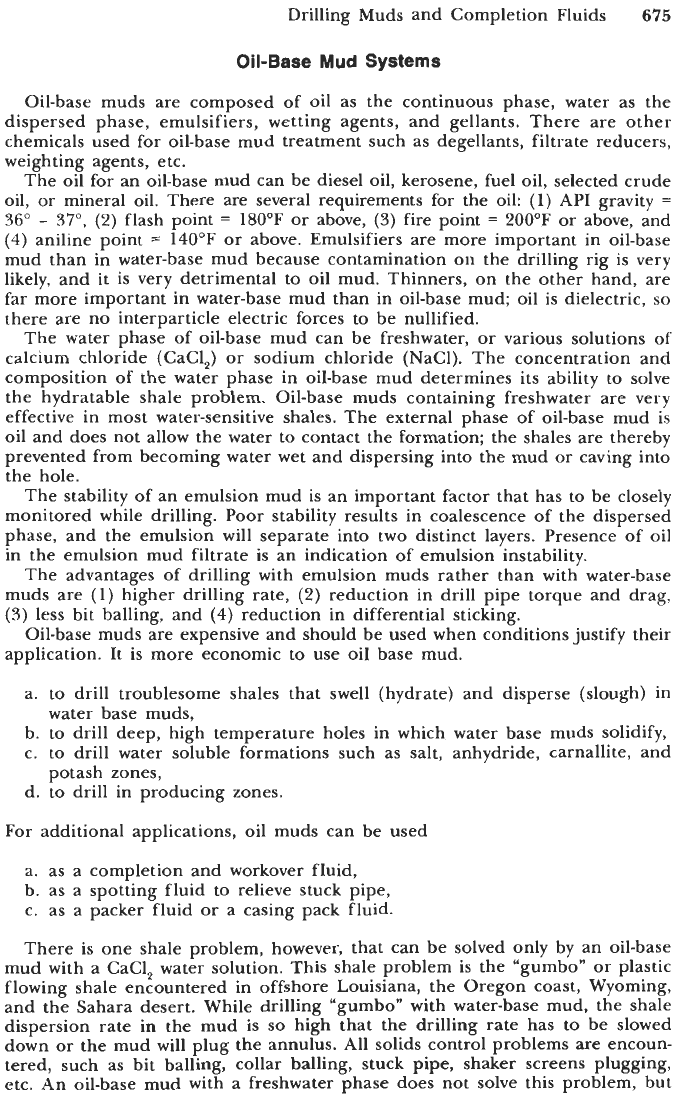
Drilling Muds and Completion Fluids
675
Oil-Base
Mud
Systems
Oil-base muds are composed of oil as the continuous phase, water as the
dispersed phase, emulsifiers, wetting agents, and gellants. There are other
chemicals used for oil-base mud treatment such as degellants, filtrate reducers,
weighting agents, etc.
The oil for an oil-base mud can be diesel oil, kerosene, fuel oil, selected crude
oil, or mineral oil. There are several requirements for the oil:
(1)
API
gravity
=
36”
-
37”,
(2)
flash point
=
180°F
or above,
(3)
fire point
=
200°F
or above, and
(4)
aniline point
=
140°F or above. Emulsifiers are more important in oil-base
mud than in water-base mud because contamination
on
the drilling rig is very
likely, and it is very detrimental to
oil
mud. Thinners, on the other hand, are
far more important in water-base mud than in oil-base mud; oil is dielectric,
so
there are no interparticle electric forces to be nullified.
The water phase of oil-base mud can be freshwater, or various solutions
of
calcium chloride (CaCl,) or sodium chloride (NaCl). The concentration and
composition of the water phase in oil-base mud determines its ability to solve
the hydratable shale problem. Oil-base muds containing freshwater are very
effective in most water-sensitive shales. The external phase of oil-base mud is
oil and does not allow the water to contact the formation; the shales are thereby
prevented from becoming water wet and dispersing into the mud or caving into
the hole.
The stability of an emulsion mud is an important factor that has to be closely
monitored while drilling. Poor stability results in coalescence
of
the dispersed
phase, and the emulsion will separate into two distinct layers. Presence
of
oil
in the emulsion mud filtrate is an indication of emulsion instability.
The advantages of drilling with emulsion muds rather than with water-base
muds are
(1)
higher drilling rate,
(2)
reduction in drill pipe torque and drag,
(3)
less bit balling, and
(4)
reduction in differential sticking.
Oil-base muds are expensive and should be used when conditions justify their
application. It is more economic to use oil base mud.
a. to drill troublesome shales that swell (hydrate) and disperse (slough) in
b. to drill deep, high temperature holes in which water base muds solidify,
c. to drill water soluble formations such as salt, anhydride, carnallite, and
d. to drill in producing zones.
water base muds,
potash zones,
For additional applications, oil muds can be used
a. as a completion and workover fluid,
b. as a spotting fluid to relieve stuck pipe,
c. as a packer fluid or a casing pack fluid.
There is one shale problem, however, that can be solved only by an oil-base
mud with a CaCl, water solution. This shale problem is the “gumbo” or plastic
flowing shale encountered in offshore Louisiana, the Oregon coast, Wyoming,
and the Sahara desert. While drilling “gumbo” with water-base mud, the shale
dispersion rate in the mud is
so
high that the drilling rate has to be slowed
down or the mud will plug the annulus. AI1 solids control problems are encoun-
tered, such as bit balling, collar balling, stuck pipe, shaker screens plugging,
etc. An oil-base mud with a freshwater phase does not solve this problem, but
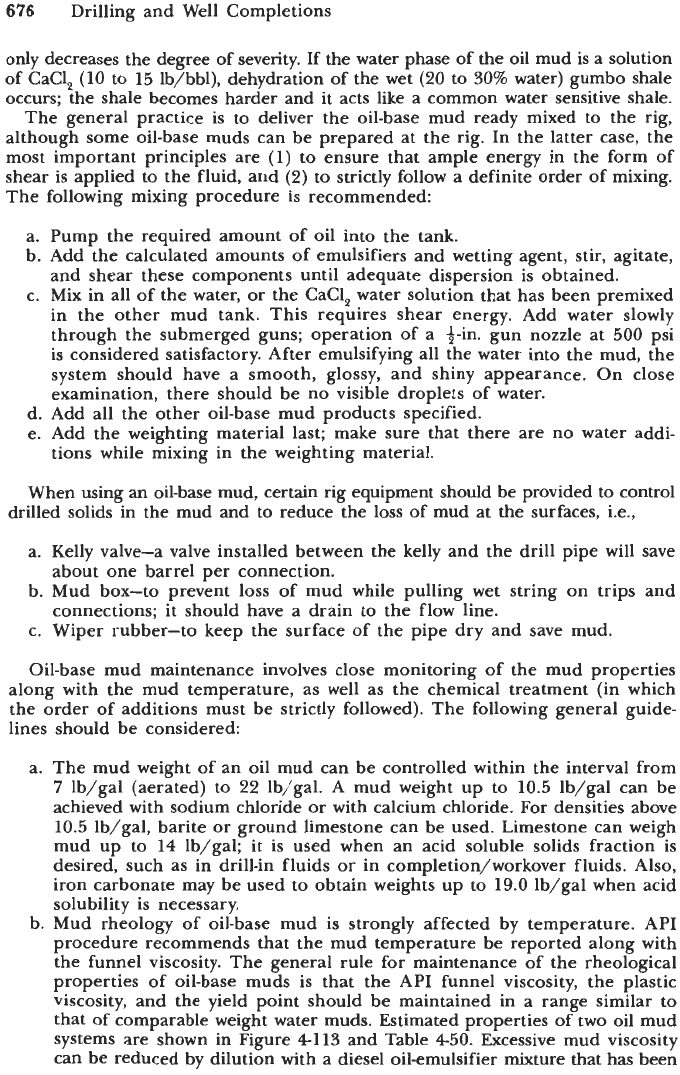
676
Drilling and Well Completions
only decreases the degree of seventy. If the water phase of the oil mud is a solution
of CaCl, (10 to 15 lb/bbl), dehydration of the wet
(20
to
30%
water) gumbo shale
occurs; the shale becomes harder and it acts like a common water sensitive shale.
The general practice is to deliver the oil-base mud ready mixed to the rig,
although some oil-base muds can be prepared at the rig. In the latter case, the
most important principles are
(1)
to ensure that ample energy in the form of
shear is applied to the fluid, and
(2)
to strictly follow a definite order of mixing.
The following mixing procedure is recommended:
a. Pump the required amount of oil into the tank.
b. Add the calculated amounts of emulsifiers and wetting agent, stir, agitate,
and shear these components until adequate dispersion is obtained.
c. Mix in all of the water, or the CaCl, water solution that has been premixed
in the other mud tank. This requires shear energy. Add water slowly
through the submerged guns; operation of a +-in. gun nozzle at
500
psi
is considered satisfactory. After emulsifying all the water into the mud, the
system should have a smooth, glossy, and shiny appearance. On close
examination, there should be no visible droplets of water.
d. Add all the other oil-base mud products specified.
e. Add the weighting material last; make sure that there are no water addi-
tions while mixing in the weighting material.
When using an oil-base mud, certain rig equipment should be provided to control
drilled solids in the mud and to reduce the loss of mud at the surfaces, i.e.,
a. Kelly valve-a valve installed between the kelly and the drill pipe will save
b. Mud box-to prevent loss of mud while pulling wet string on trips and
c. Wiper rubber-to keep the surface of the pipe dry and save mud.
Oil-base mud maintenance involves close monitoring of the mud properties
along with the mud temperature, as well as the chemical treatment (in which
the order of additions must be strictly followed). The following general guide-
lines should be considered:
about one barrel per connection.
connections; it should have a drain to the flow line.
a. The mud weight of an oil mud can be controlled within the interval from
7
lb/gal (aerated) to
22
lb/gal. A mud weight up to 10.5 lb/gal can be
achieved with sodium chloride or with calcium chloride. For densities above
10.5 lb/gal, barite or ground limestone can be used. Limestone can weigh
mud up to 14 lb/gal; it is used when an acid soluble solids fraction is
desired, such as in drill-in fluids or in completion/workover fluids. Also,
iron carbonate may be used to obtain weights up to 19.0 lb/gal when acid
solubility is necessary.
b. Mud rheology of oil-base mud is strongly affected by temperature. API
procedure recommends that the mud temperature be reported along with
the funnel viscosity. The general rule for maintenance of the rheological
properties of oil-base muds is that the API funnel viscosity, the plastic
viscosity, and the yield point should be maintained in a range similar to
that of comparable weight water muds. Estimated properties of two oil mud
systems are shown in Figure 4113
and
Table 450. Excessive mud viscosity
can be reduced by dilution with a diesel oil-emulsifier mixture that has been
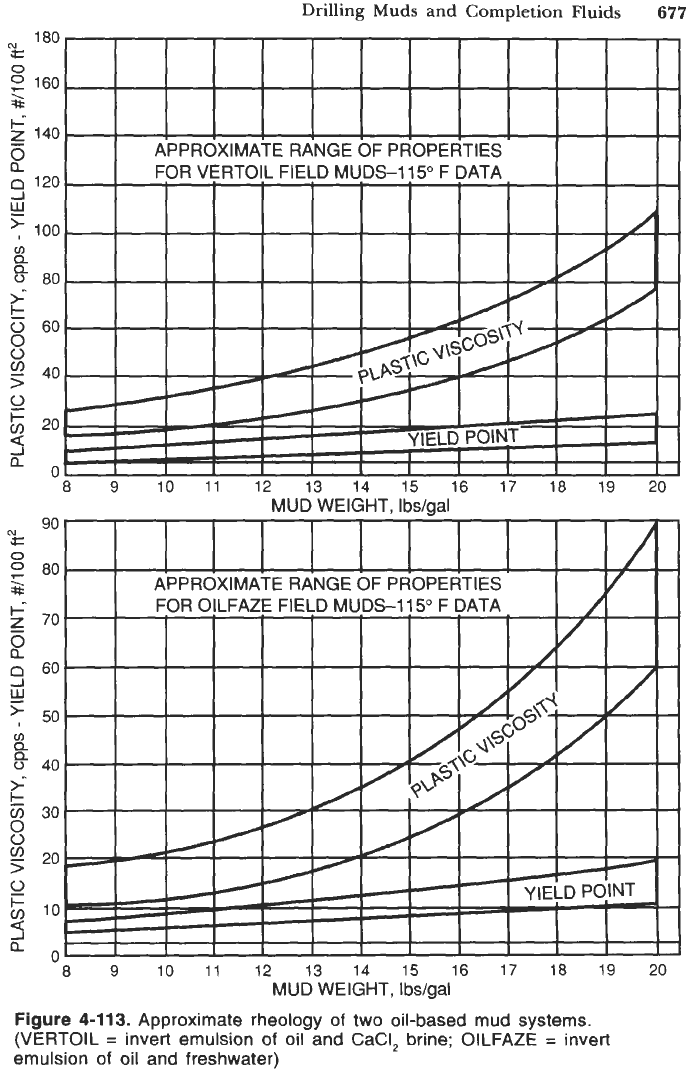
Drilling Muds and Completion Fluids
677
0
I-
v)
4
a
80
60
40
-
APPROXIMATE RANGE
OF
PROPERTIES
N
e
0
0
7-
P
I--
z
2
u)
Q
Q
0
g-
v)
0
0
2
>
90
80
70
60
50
40
30
20
10
"
8 9 10 11
12
13 14 15 16 17 18 19
20
MUD
WEIGHT, Ibs/gal
Figure
4-11
3.
Approximate rheology of two oil-based mud systems.
(VERTOIL
=
invert emulsion
of
oil and CaCI, brine: OILFAZE
=
invert
emulsion of oil and freshwater)

678
Drilling and Well Completions
Table
4-50
Estimated Requirements for
Oil
Mud Properties
Mud Weight
Plastic Viscosity Yield Point
PP9
CP
I
bsll00
ft2
Oil-Water Ratio
a-1
0
1
5-30
5-1
0
65135-75125
10-12 20-40 6-1 4 75125-ao120
12-1
4
25-50 7-1 6 ao120-a5115
14-1 6
30-60
10-1 9 a511 5-aaii 2
16-18 40-80 12-22
aaii
5-921a
~ ~~
Electrical
Stability
200-300
300-400
500-600
above
600
400-500
agitated in a separate tank. Insufficient viscosity can be corrected either by
adding water (pilot testing required) or by treatment with a gellant.
c. There is no general upper limit on drilled solids concentration in oil muds,
such as there is for water-base
muds.
However, a daily log of solids content
enables the engineer to quickly determine a solids level at which the mud
system performs properly.
d. Water wet solids is a very serious problem; in sever cases, uncontrollable
barite settling may result. If there are any positive signs of water wet solids,
a wetting agent should be added immediately. Tests for water wet solids
should be run daily.
e. The dispersed water phase of an oil-base mud should be maintained in an
alkaline pH range (Le., pH above
7).
Temperature stability as well as
emulsion stability depends upon the proper alkalinity maintenance. If the
concentration of lime is too low, the solubility of the emulsifier changes
and the emulsion loses its stability. On the other hand, overtreatment with
lime results in water wetting problems. Therefore, the daily lime mainte-
nance has to be established and controlled by alkalinity testing. The recom-
mended range of lime content for oil-base muds is from
2
to
4
lb/bbl.
f.
CaCl, content should be checked daily and corrected.
g. The oil-water ratio influences viscosity and HT-HP (high-temperature-
high-pressure) filtration of the oil-base mud. Retort analysis is used to
detect any change in the oil-water ratio, giving the engineer a method for
controlling the viscosity of the liquid phase by maintaining a relatively
constant oil-water ratio.
h. Electrical stability is a measure of how well the water is emulsified in the
continuous oil phase. Since many factors affect the electrical stability
of
oil-base muds, the test does not necessarily indicate that a particular oil-
base mud is in good or in poor condition. For this reason, values are
relative to the system for which they are being recorded. Stability measure-
ments should be made routinely, and the values recorded and plotted
so
that trends may be noted. Any change in electrical stability indicates a
change in the system.
i.
HT-HP filtration should exhibit a low filtrate volume (about
3
ml). The
filtrate should be water-free; water in the filtrate indicates a poor emulsion,
probably caused by water wetting of solids.
Gaseous Drilling Mud Systems
The basic gaseous drilling fluids and their characteristics are presented in
Table
4-51.
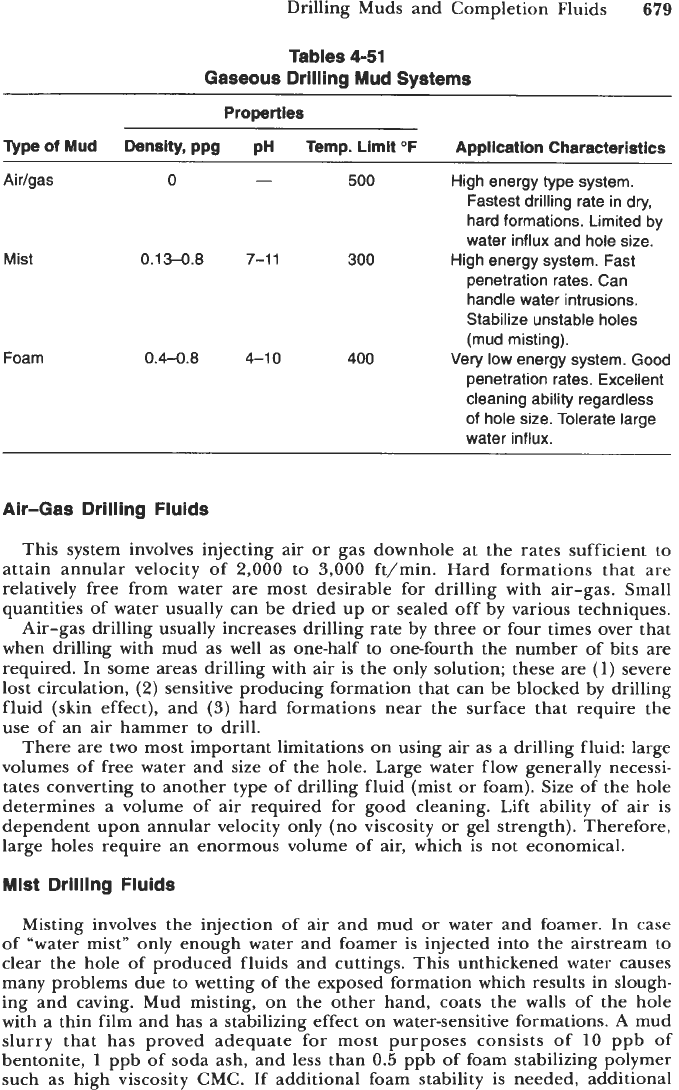
Drilling Muds and Completion Fluids
679
Tables
4-51
Gaseous Drilling
Mud
Systems
Properties
Qpe
of
Mud
Density, ppg pH Temp. Limit
OF
Application Characteristics
Airlgas
0
500
High energy type system.
-
Fastest drilling rate in dry,
hard formations. Limited by
water influx and hole size.
Mist 0.13-0.8 7-11
300
High energy system. Fast
penetration rates. Can
handle water intrusions.
Stabilize unstable holes
(mud misting).
penetration rates. Excellent
cleaning ability regardless
of hole size. Tolerate large
water influx.
0.4-0.8
4-10 400 Very low energy system. Good
Foam
Air-Gas Drilling Fluids
This system involves injecting air or gas downhole at the rates sufficient to
attain annular velocity of
2,000
to
3,000
ft/min. Hard formations that are
relatively free from water are most desirable for drilling with air-gas. Small
quantities of water usually can be dried up or sealed off by various techniques.
Air-gas drilling usually increases drilling rate by three or four times over that
when drilling with mud as well as one-half to one-fourth the number of bits are
required. In some areas drilling with air is the only solution; these are
(1)
severe
lost circulation,
(2)
sensitive producing formation that can be blocked by drilling
fluid (skin effect), and
(3)
hard formations near the surface that require the
use of an air hammer to drill.
There are two most important limitations on using air as a drilling fluid: large
volumes of free water and size of the hole. Large water flow generally necessi-
tates converting to another type of drilling fluid (mist or foam). Size of the hole
determines a volume of air required for good cleaning. Lift ability of air is
dependent upon annular velocity only (no viscosity or gel strength). Therefore,
large holes require an enormous volume of air, which is not economical.
Mist Drilling Fluids
Misting involves the injection of air and mud
or
water and foamer.
In
case
of “water mist” only enough water and foamer is injected into the airstream to
clear the hole of produced fluids and cuttings. This unthickened water causes
many problems due to wetting of the exposed formation which results in slough-
ing and caving. Mud misting, on the other hand, coats the walls of the hole
with a thin film and has a stabilizing effect on water-sensitive formations. A mud
slurry that has proved adequate for most purposes consists of
10
ppb
of
bentonite,
1
ppb of soda ash, and less than
0.5
ppb of foam stabilizing polymer
such as high viscosity CMC. If additional foam stability is needed, additional
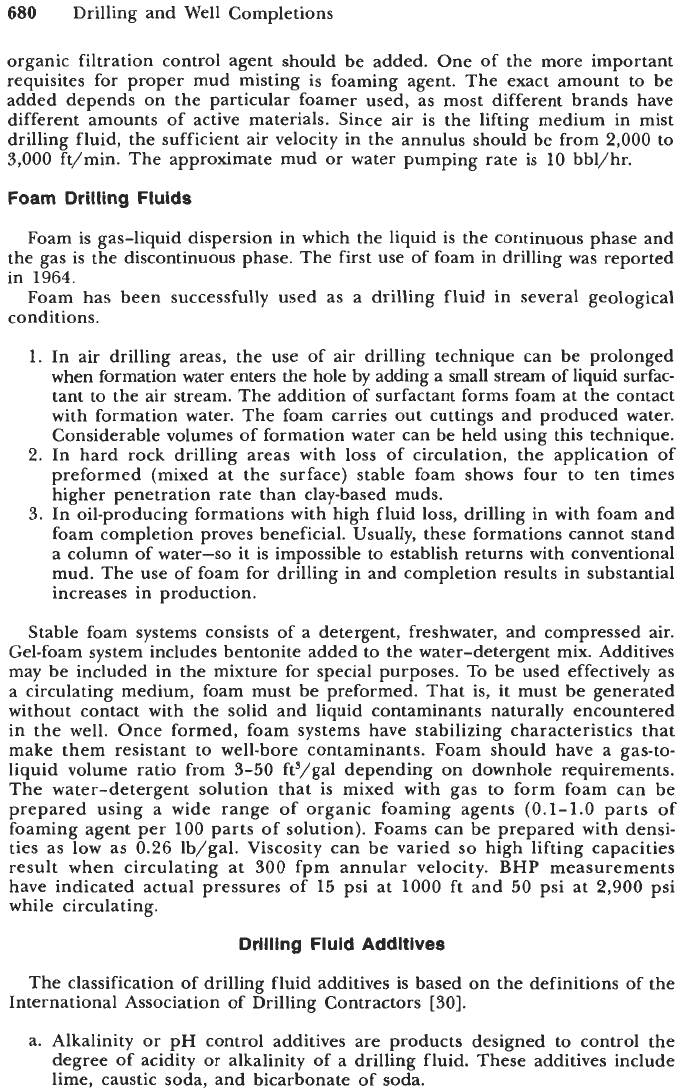
680
Drilling and Well Completions
organic filtration control agent should be added. One of the more important
requisites for proper mud misting is foaming agent. The exact amount to be
added depends on the particular foamer used, as most different brands have
different amounts of active materials. Since air is the lifting medium in mist
drilling fluid, the sufficient air velocity in the annulus should be from
2,000
to
3,000
ft/min. The approximate mud or water pumping rate is
10
bbl/hr.
Foam
Drilling
Fluids
Foam is gas-liquid dispersion in which the liquid is the continuous phase and
the gas is the discontinuous phase. The first use of foam in drilling was reported
in 1964.
Foam has been successfully used as a drilling fluid in several geological
conditions.
1.
In air drilling areas, the use of air drilling technique can be prolonged
when formation water enters the hole by adding a small stream of liquid surfac-
tant to the air stream. The addition of surfactant forms foam at the contact
with formation water. The foam carries out cuttings and produced water.
Considerable volumes of formation water can be held using this technique.
2.
In hard rock drilling areas with loss of circulation, the application of
preformed (mixed at the surface) stable foam shows four to ten times
higher penetration rate than clay-based muds.
3.
In oil-producing formations with high fluid loss, drilling in with foam and
foam completion proves beneficial. Usually, these formations cannot stand
a column of water-so it is impossible to establish returns with conventional
mud. The use of foam for drilling in and completion results in substantial
increases in production.
Stable foam systems consists of a detergent, freshwater, and compressed air.
Gel-foam system includes bentonite added to the water-detergent mix. Additives
may be included in the mixture for special purposes. To be used effectively
as
a circulating medium, foam must be preformed. That is, it must be generated
without contact with the solid and liquid contaminants naturally encountered
in the well. Once formed, foam systems have stabilizing characteristics that
make them resistant to well-bore contaminants. Foam should have a gas-to-
liquid volume ratio from
3-50
ft3/gal depending on downhole requirements.
The water-detergent solution that is mixed with gas to form foam can be
prepared using a wide range of organic foaming agents
(0.1-1.0
parts of
foaming agent per
100
parts of solution). Foams can be prepared with densi-
ties as low as
0.26
lb/gal. Viscosity can be varied
so
high lifting capacities
result when circulating at
300
fpm annular velocity. BHP measurements
have indicated actual pressures of 15 psi at
1000
ft and
50
psi at 2,900 psi
while circulating.
Drilling Fluid Additives
The classification of drilling fluid additives is based on the definitions of the
International Association
of
Drilling Contractors
[30].
a. Alkalinity or pH control additives are products designed to control the
degree of acidity or alkalinity of a drilling fluid. These additives include
lime, caustic soda, and bicarbonate of soda.
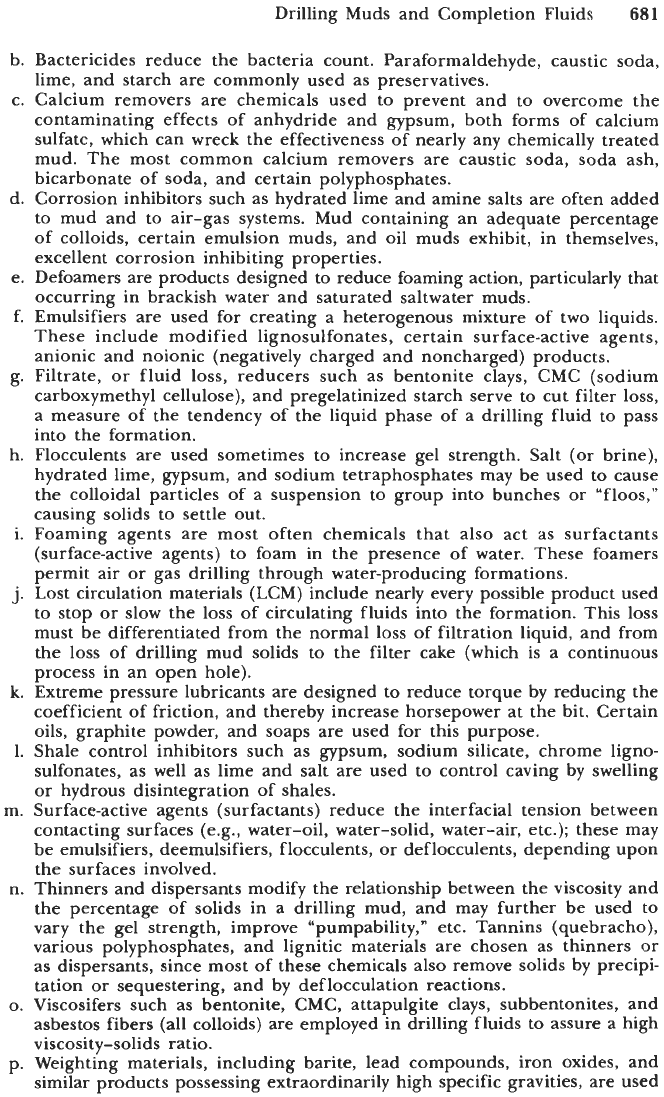
Drilling Muds and Completion Fluids
681
b. Bactericides reduce the bacteria count. Paraformaldehyde, caustic soda,
lime, and starch are commonly used as preservatives.
c. Calcium removers are chemicals used to prevent and to overcome the
contaminating effects of anhydride and gypsum, both forms of calcium
sulfate, which can wreck the effectiveness of nearly any chemically treated
mud. The most common calcium removers are caustic soda, soda ash,
bicarbonate of soda, and certain polyphosphates.
d. Corrosion inhibitors such as hydrated lime and amine salts are often added
to mud and to air-gas systems. Mud containing an adequate percentage
of
colloids, certain emulsion muds, and oil muds exhibit, in themselves,
excellent corrosion inhibiting properties.
e. Defoamers are products designed to reduce foaming action, particularly that
occurring in brackish water and saturated saltwater muds.
f.
Emulsifiers are used for creating a heterogenous mixture of two liquids.
These include modified lignosulfonates, certain surface-active agents,
anionic and noionic (negatively charged and noncharged) products.
g. Filtrate, or fluid loss, reducers such as bentonite clays, CMC (sodium
carboxymethyl cellulose), and pregelatinized starch serve to cut filter loss,
a measure of the tendency of the liquid phase of a drilling fluid to pass
into the formation.
h. Flocculents are used sometimes to increase gel strength. Salt (or brine),
hydrated lime, gypsum, and sodium tetraphosphates may be used to cause
the colloidal particles of a suspension to group into bunches or “floos,”
causing solids to settle out.
i. Foaming agents are most often chemicals that also act as surfactants
(surface-active agents) to foam in the presence of water. These foamers
permit air or gas drilling through water-producing formations.
j.
Lost circulation materials (LCM) include nearly every possible product used
to stop or slow the loss of circulating fluids into the formation. This loss
must be differentiated from the normal loss of filtration liquid, and from
the loss of drilling mud solids to the filter cake (which is a continuous
process in an open hole).
k. Extreme pressure lubricants are designed to reduce torque by reducing the
coefficient of friction, and thereby increase horsepower at the bit. Certain
oils, graphite powder, and soaps are used for this purpose.
1.
Shale control inhibitors such as gypsum, sodium silicate, chrome ligno-
sulfonates, as well as lime and salt are used to control caving by swelling
or hydrous disintegration of shales.
m. Surface-active agents (surfactants) reduce the interfacial tension between
contacting surfaces (e.g., water-oil, water-solid, water-air, etc.); these may
be emulsifiers, deemulsifiers, flocculents, or deflocculents, depending upon
the surfaces involved.
n. Thinners and dispersants modify the relationship between the viscosity and
the percentage of solids in a drilling mud, and may further be used to
vary the gel strength, improve “pumpability,” etc. Tannins (quebracho),
various polyphosphates, and lignitic materials are chosen as thinners or
as dispersants, since most of these chemicals also remove solids by precipi-
tation or sequestering, and by deflocculation reactions.
0.
Viscosifers such as bentonite, CMC, attapulgite clays, subbentonites, and
asbestos fibers (all colloids) are employed in drilling fluids to assure a high
viscosity-solids ratio.
p. Weighting materials, including barite, lead compounds, iron oxides, and
similar products possessing extraordinarily high specific gravities, are used
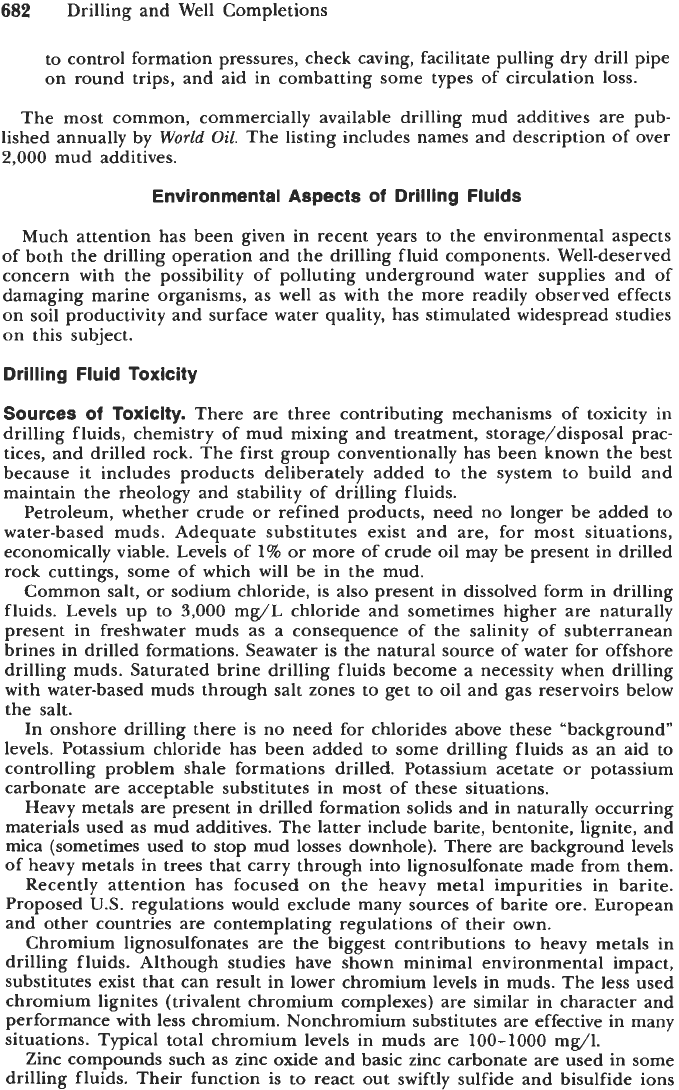
682
Drilling and Well Completions
to control formation pressures, check caving, facilitate pulling dry drill pipe
on round trips, and aid in combatting some types of circulation loss.
The most common, commercially available drilling mud additives are pub-
lished annually by
World
Oil.
The listing includes names and description of over
2,000
mud additives.
Environmental Aspects
of
Drilling Fluids
Much attention has been given in recent years to the environmental aspects
of both the drilling operation and the drilling fluid components. Well-deserved
concern with the possibility of polluting underground water supplies and of
damaging marine organisms, as well as with the more readily observed effects
on soil productivity and surface water quality, has stimulated widespread studies
on this subject.
Drilling Fluid Toxicity
Sources
of
Toxicity.
There are three contributing mechanisms of toxicity in
drilling fluids, chemistry of mud mixing and treatment, storage/disposal prac-
tices, and drilled rock. The first group conventionally has been known the best
because it includes products deliberately added to the system to build and
maintain the rheology and stability of drilling fluids.
Petroleum, whether crude or refined products, need no longer be added to
water-based muds. Adequate substitutes exist and are, for most situations,
economically viable. Levels of
1%
or more of crude oil may be present in drilled
rock cuttings, some of which will be in the mud.
Common salt, or sodium chloride, is also present in dissolved form in drilling
fluids. Levels up to
3,000
mg/L chloride and sometimes higher are naturally
present in freshwater muds as a consequence of the salinity of subterranean
brines in drilled formations. Seawater is the natural source of water for offshore
drilling muds. Saturated brine drilling fluids become a necessity when drilling
with water-based muds through salt zones to get to oil and gas reservoirs below
the salt.
In onshore drilling there is no need for chlorides above these “background”
levels. Potassium chloride has been added to some drilling fluids as an aid to
controlling problem shale formations drilled. Potassium acetate or potassium
carbonate are acceptable substitutes in most of these situations.
Heavy metals are present in drilled formation solids and in naturally occurring
materials used as mud additives. The latter include barite, bentonite, lignite, and
mica (sometimes used to stop mud losses downhole). There are background levels
of heavy metals in trees that carry through into lignosulfonate made from them.
Recently attention has focused on the heavy metal impurities in barite.
Proposed
U.S.
regulations would exclude many sources of barite ore. European
and other countries are contemplating regulations of their own.
Chromium lignosulfonates are the biggest contributions to heavy metals in
drilling fluids. Although studies have shown minimal environmental impact,
substitutes exist that can result in lower chromium levels in muds. The less used
chromium lignites (trivalent chromium complexes) are similar in character and
performance with less chromium. Nonchromium substitutes are effective in many
situations. Typical total chromium levels in muds are
100-1000
mg/l.
Zinc compounds such as zinc oxide and basic zinc carbonate are used in some
drilling fluids. Their function is to react out swiftly sulfide and bisulfide ions
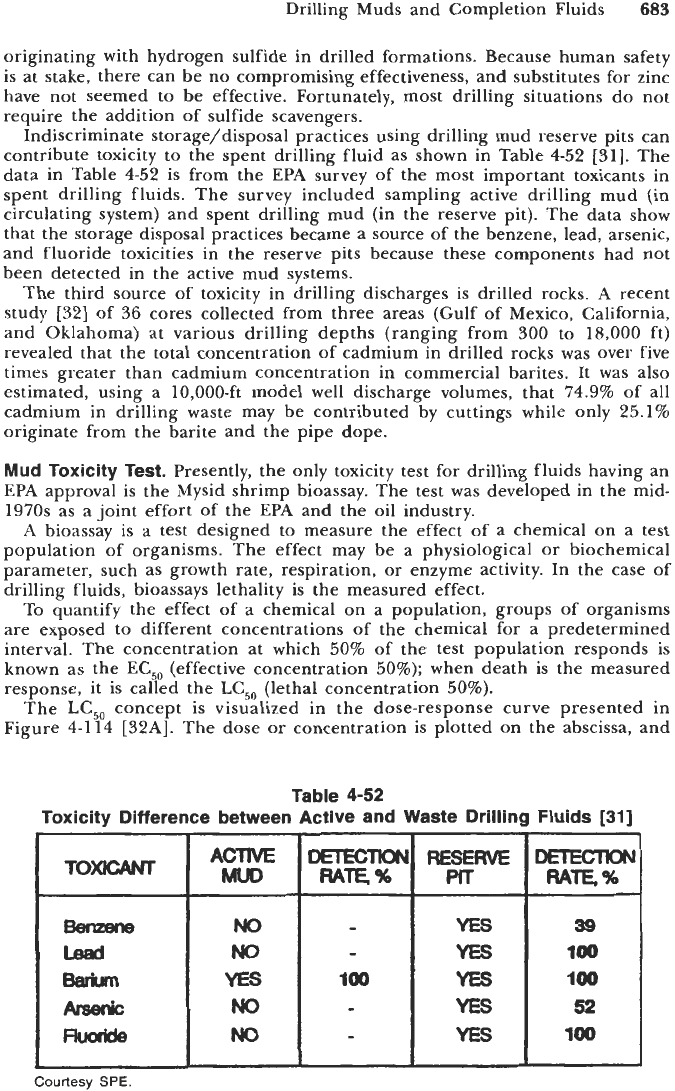
Drilling Muds and Completion Fluids
683
T0)aCANT
Bemene
Lsad
Batium
Arsenic
Fluaride
originating with hydrogen sulfide in drilled formations. Because human safety
is at stake, there can be no compromising effectiveness, and substitutes for zinc
have not seemed to be effective. Fortunately, most drilling situations do not
require the addition of sulfide scavengers.
Indiscriminate storage/disposal practices using drilling mud reserve pits can
contribute toxicity to the spent drilling fluid as shown in Table
4-52
[31].
The
data in Table
4-52
is from the EPA survey of the most important toxicants in
spent drilling fluids. The survey included sampling active drilling mud (in
circulating system) and spent drilling mud (in the reserve pit). The data show
that the storage disposal practices became a source of the benzene, lead, arsenic,
and fluoride toxicities in the reserve pits because these components had not
been detected in the active mud systems.
The third source of toxicity in drilling discharges is drilled rocks.
A
recent
study
[32]
of
36
cores collected from three areas (Gulf of Mexico, California,
and Oklahoma) at various drilling depths (ranging from
300
to
18,000
ft)
revealed that the total concentration of cadmium in drilled rocks was over five
times greater than cadmium concentration in commercial barites. It was also
estimated, using a 10,000-ft model well discharge volumes, that
74.9%
of
all
cadmium in drilling waste may be contributed by cuttings while only
25.1%
originate from the barite and the pipe dope.
Mud Toxicity Test.
Presently, the only toxicity test for drilling fluids having an
EPA
approval is the Mysid shrimp bioassay. The test was developed in the mid-
1970s
as a joint effort of the EPA and the oil industry.
A
bioassay is a test designed to measure the effect of a chemical on a test
population
of
organisms. The effect may be a physiological or biochemical
parameter, such as growth rate, respiration,
or
enzyme activity. In the case of
drilling fluids, bioassays lethality is the measured effect.
To quantify the effect of a chemical on a population, groups of organisms
are exposed to different concentrations
of
the chemical for a predetermined
interval. The concentration at which
50%
of the test population responds is
known as the EC,, (effective concentration
50%);
when death is the measured
response, it is called the
LC,,
(lethal concentration
50%).
The
LC,,
concept is visualized in the dose-response curve presented in
Figure 4-114
[32A].
The dose or concentration is plotted on the abscissa, and
ACTM
~ECTIONRESERVEDETECTW
EmJo
ME%
PIT
ME%
No
-
YES
39
No
-
YES
loo
YES
loo
YES
loo
No
YES 52
No
-
YES
loo
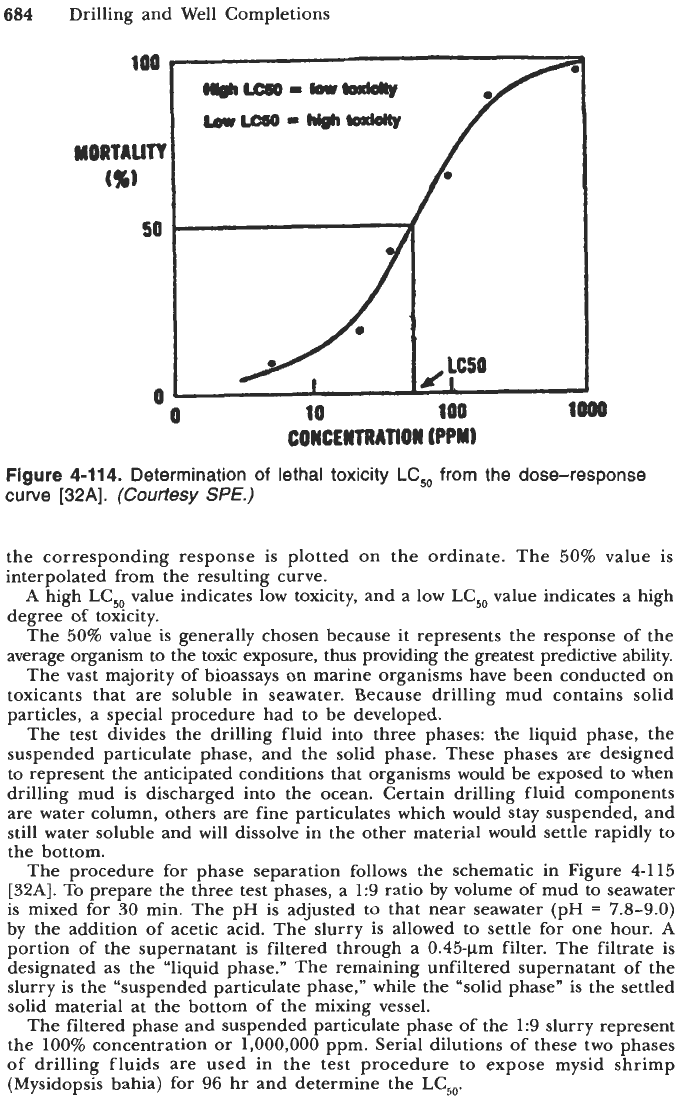
684
Drilling and Well Completions
100
w-=w-w
brr-*Ngh(axkl(r
MORTAUTY
CJO
sa
0
10
100
loo0
0
COWCENTRAllO~
IPPY)
Figure
4-11
4.
Determination
of
lethal toxicity LC,, from the dose-response
curve
[32A].
(Courtesy
SPE.)
the corresponding response is plotted on the ordinate. The 50% value is
interpolated from the resulting curve.
A
high LC,, value indicates low toxicity, and a low LC,, value indicates a high
degree of toxicity.
The 50% value is generally chosen because it represents the response
of
the
average organism to the toxic exposure, thus providing the greatest predictive ability.
The vast majority of bioassays on marine organisms have been conducted on
toxicants that are soluble in seawater. Because drilling mud contains solid
particles, a special procedure had to be developed.
The test divides the drilling fluid into three phases: the liquid phase, the
suspended particulate phase, and the solid phase. These phases are designed
to represent the anticipated conditions that organisms would be exposed to when
drilling mud is discharged into the ocean. Certain drilling fluid components
are water column, others are fine particulates which would stay suspended, and
still water soluble and will dissolve in the other material would settle rapidly to
the bottom.
The procedure for phase separation follows the schematic in Figure 4-115
[32A].
To prepare the three test phases, a
1:9
ratio by volume of mud to seawater
is mixed for
30
min. The pH is adjusted to that near seawater (pH
=
7.8-9.0)
by the addition of acetic acid. The slurry is allowed to settle for one hour.
A
portion
of
the supernatant is filtered through a 0.45-pm filter. The filtrate is
designated as the “liquid phase.” The remaining unfiltered supernatant of the
slurry is the “suspended particulate phase,” while the “solid phase” is the settled
solid material at the bottom of the mixing vessel.
The filtered phase and suspended particulate phase of the
1:9
slurry represent
the
100%
concentration
or
1,000,000
ppm. Serial dilutions of these two phases
of drilling fluids are used in the test procedure to expose mysid shrimp
(Mysidopsis bahia) for
96
hr and determine the LC,,.
